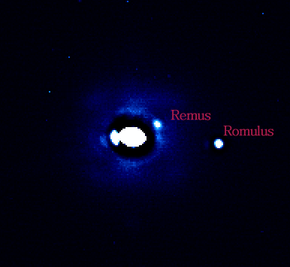 Adaptive Optics observations of (87) Sylvia, showing its two satellites, Remus and Romulus. | |
| Discovery[1] | |
|---|---|
| Discovered by | |
| Discovery date | 18 February 2001 |
| Designations | |
| Sylvia I | |
| Pronunciation | /ˈrɒmjʊləs/ |
Named after | Rōmulus |
| |
| Main belt (Cybele) | |
| Adjectives | Romulian,[2] -ean[3] (both /rɒˈmjuːliən/) |
| Orbital characteristics[4] | |
| Epoch 1 September 2004 (JD 1795812.5) | |
| 1351.35±0.1 km | |
| Eccentricity | 0.0069±0.0037 |
| 3.6496+0.025 −0.024 d | |
Average orbital speed | 27.0 m/s |
| 167°±23° | |
| Inclination | 1.7°±1.0° (with respect to Sylvia equator) |
| 93.17°±1.85° | |
| 175°±23° | |
| Satellite of | 87 Sylvia |
| Physical characteristics | |
| Dimensions | 10.8±5.6 km[4] |
| Mass | 9.319+20.7 −8.3×1014 kg[4] |
Equatorial escape velocity | ~ 4.8 m/s (estimate) [citation needed] |
| 10.7[5] | |
Romulus is the outer and larger moon of the main-belt asteroid 87 Sylvia. It follows an almost-circular and close-to-equatorial orbit around the asteroid. In this respect it is similar to the other Sylvian moon Remus.
Discovery and naming
Romulus was discovered in February 2001 from the Keck II telescope by Michael E. Brown and Jean-Luc Margot. Its full designation is (87) Sylvia I Romulus; before receiving its name, it was known as S/2001 (87) 1. The moon is named after Romulus, the mythological founder of Rome, one of the twins of Rhea Silvia raised by a wolf.
Characteristics
87 Sylvia has a low density, which indicates that it is probably a rubble pile formed when debris from a collision between its parent body and another asteroid re-accreted gravitationally. Therefore, it is likely that both Romulus and Remus, the second of Sylvia's moons, are smaller rubble piles which accreted in orbit around the main body from debris of the same collision. In this case their albedo and density are expected to be similar to Sylvia's.[5]
Romulus's orbit is expected to be quite stable − it lies far inside Sylvia's Hill sphere (about 1/50 of Sylvia's Hill radius), but also far outside the synchronous orbit.[5]
From Romulus's surface, Sylvia takes up an angular region 16°×10° across, while Remus's apparent size varies between 0.62° and 0.19° (for comparison, Earth's Moon has an apparent size of about 0.5°).
See also
References
- ^ IAUC 7588, announcing the discovery of S/2001 (87) 1
- ^ Clark (1919) History of Roman private law, v. 3
- ^ Rodríguez-Adrados, van Dijk, & Ray (2000) History of the Graeco-Latin Fable
- ^ a b c Fang, Julia; Margot, Jean-Luc; Rojo, Patricio (16 July 2012). "Orbits, Masses, and Evolution of Main Belt Triple (87) Sylvia". The Astronomical Journal. 144 (2): 70. arXiv:1206.5755. Bibcode:2012AJ....144...70F. doi:10.1088/0004-6256/144/2/70. S2CID 55173059.
- ^ a b c F. Marchis; et al. (2005). "Discovery of the triple asteroidal system 87 Sylvia". Nature. 436 (7052): 822–4. Bibcode:2005Natur.436..822M. doi:10.1038/nature04018. PMID 16094362. S2CID 4412813.
External links
- Data on (87) Sylvia from Johnston's archive (maintained by W. R. Johnston)
- Rubble-Pile Minor Planet Sylvia and Her Twins (ESO news release, August 2005) Includes images and artists impressions
- Adaptive Optics System Reveals New Asteroidal Satellite (SpaceDaily.com, March 2001) Includes a discovery image.
- IAUC 7590, confirming the discovery of S/2001 (87) 1
- IAUC 8582, reporting discovery of S/2004 (87) 1 and naming Romulus and Remus
